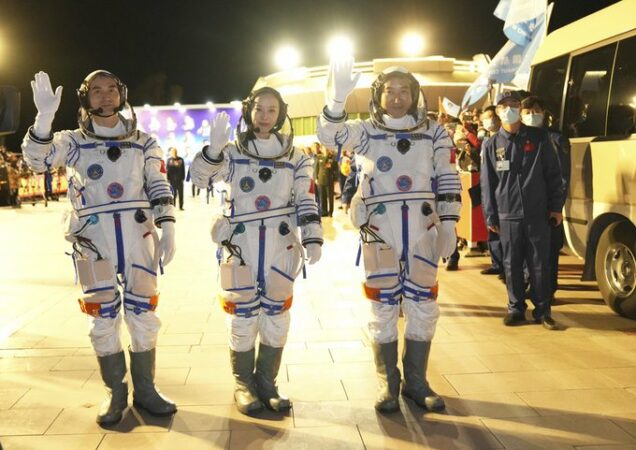15th October, 2021
By Xinhua and Reuters
China on Saturday launched the crewed spaceship Shenzhou-13, sending three astronauts to its space station core module Tianhe for a six-month mission.
The spacecraft, atop a Long March-2F carrier rocket, was launched from the Jiuquan Satellite Launch Center in northwest China’s Gobi Desert at 12:23 a.m. (Beijing Time), according to the China Manned Space Agency (CMSA).
About 582 seconds after the launch, Shenzhou-13 separated from the rocket and entered its designated orbit.
The crew members are in good shape and the launch is a complete success, the CMSA declared.
It is the 21st flight mission since the country’s manned space program was approved and initiated, and the second crewed mission for China’s space station project.
The three astronauts are Zhai Zhigang, the commander and China’s first spacewalker, Wang Yaping, the first Chinese female astronaut to visit China’s space station and carry out extravehicular activities.
The third astronauts is Ye Guangfu, a newcomer to space.
They are expected to set a new record for China’s manned space mission duration, exceeding the three months kept by the Shenzhou-12 crew from June to September this year.
After entering orbit, the Shenzhou-13 spaceship will conduct a fast automated rendezvous and docking with the in-orbit combination composed of the space station core module Tianhe and the cargo craft Tianzhou-2 and Tianzhou-3.
The astronauts will be stationed in the core module.
They will have assignments including operating mechanical arms, performing extra-vehicular activities, and having module transfer tests.
They will also continue to verify key technologies concerning astronauts’ long-term stay in orbit, as well as recycle and life support.
Tianzhou-3, carrying supplies for the Shenzhou-13 crewed mission, was launched and docked at the rear docking port of Tianhe on Sept. 20.
Currently, the complex formed by Tianhe and the two cargo craft has entered an orbit for docking, ready for docking with the Shenzhou-13 spacecraft and boarding of the three astronauts.
Five launch missions had been planned for this year, namely the launch of the Tianhe core module, Tianzhou-2 cargo ship, Shenzhou-12 crewed mission, Tianzhou-3 cargo ship and Shenzhou-13 crewed mission
The astronauts
The mission commander is Zhai Zhigang, 55, from China’s very first batch of astronaut trainees in the late 1990s.
Born to a rural family of six children, Zhai carried out China’s first spacewalk in 2008.
Shenzhou-13 was his second space mission.
“The most challenging task will be the long-term stay in orbit for six months,” Zhai said at a press conference on Thursday.
“It will exact higher demands (on us), both physically and psychologically.”
Zhai was accompanied by Wang Yaping, 41, and Ye Guangfu, 41.
Wang, a mother of a five-year-old, was born to a rural family like Zhai.
Known among her colleagues for her tenacity, the former air force pilot first travelled to space in 2013, to Tiangong-1, a prototype space lab.
China has so far sent two female astronauts to space. The first was Liu Yang, in 2012.
Shenzhou-13 was the first space mission for the third astronaut, Ye.
After the return of the Shenzhou-13 crew to Earth in April next year, China will deploy six more missions, including deliveries of the second and third space station modules and two final crewed missions.
China, barred by U.S. law from working with NASA and by extension on the International Space Station (ISS), has spent the past decade developing technologies to build its own station.
With the ISS set to retire in a few years, China’s space station will become the only one in Earth’s orbit.
China’s space programme has come far since late leader Mao Zedong lamented that the country could not even launch a potato into space.
China became the third country to put a man in space with its own rocket, in October 2003, after the former Soviet Union and the United States.
